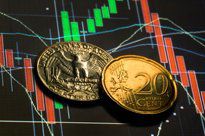
Plenty of currency traders know about the golden cross, but most don’t use it. In fact, the golden cross is one of those technical formations that just doesn’t get enough credit in the analytical community. Used correctly, however, it can be one of the best indicators of a turn in foreign exchange market trends.
What Is a Golden Cross?
A golden cross is quite simply a bullish technical formation that supports upward momentum in a current trend or a potential turnaround in a downtrending market. This formation typically stems from a cross of moving average lines or different signal lines in certain technical oscillators—like Slow Stochastics or MACD (moving average convergence divergence oscillator).
To use a golden cross, a trader simply needs to identify the shorter-term moving average or signal line rising above the longer-term component. As current or short-term prices move higher, the shorter-term component will naturally rise above average prices over the longer term. This will help to support even higher prices in the near term as trend momentum builds. Let’s take a look at a typical golden cross formation.
In Figure 1, we have a 15-minute chart of the EUR/USD currency pair. After a rapid decline from 1.4870, the currency tested 1.4760—key support at that time (left side of the chart). Notice how the golden crosses in the slow stochastic oscillator just to the left of the chart were able to confirm long buy entries in the EUR/USD (as the purple line crosses the yellow line upward). Even better, the second golden cross pays off as the foreign exchange rate rises to top off at a high of 1.4889 (over 100 pips above the support level).
Image by Sabrina Jiang © Investopedia 2021
Applying Filters and Indicators
Now, the golden cross formation seems easy, but just as with anything else in strategy and technical analysis, it’s always good to have buffers or filters in addition to the main signal. This way, there is more confirmation to take into account before placing your buy or sell entry.
Taking a look at Figure 2, we see another golden cross opportunity while using the slow stochastic. This time, moving averages are being used to confirm a shift in the EUR/CAD trend. On the left side of our hourly chart, we see that there is heavy support being established at 1.3664 (multiple session low). This extends to the right side of our chart, where the EUR/CAD is headed to test this level once again after failing to break resistance 1.3957.
Image by Sabrina Jiang © Investopedia 2021
We take a closer, more detailed look at this in Figure 3. Notice how the golden cross beats the price action to the punch, signaling a turn in the downward trend. An additional golden cross in the 10 and 25 simple moving averages confirms this idea.
Image by Sabrina Jiang © Investopedia 2021
Placing our entry at 1.3750, we attach a stop 150 pips below, at 1.3600. The wide stop is put in place to make sure the position isn’t stopped out at the support level. Now, giving the trade some time to come together, it ultimately turns in our favor, and we profit from the combination of a golden cross and a simple moving average filter. The EUR/CAD spot price bounces off of the 1.3664 support level and appreciates as expected. Figure 4 shows that our trade is able to fulfill our minimum 2-to-1 risk/reward ratio by rising straight past our take-profit point at 1.4050—topping out at 1.4171—before retracing.
Image by Sabrina Jiang © Investopedia 2021
The golden cross setup can also be used with the widely popular Bollinger Bands®.
Taking a look at a closeup of AUD/USD in the 60-minute time frame, we see another opportunity to apply the golden cross technical formation. The exchange rate has been caught in a short-term range, testing support at 1.0428 (Figure 5).
Image by Sabrina Jiang © Investopedia 2021
Now, using our Bollinger Band® application on the chart, we see that the imminent test of the support level coincides with the lower band. This is a great buy signal confirmation, as it matches the golden cross in the slow stochastic oscillator (right side of the chart). Thus, given the closeness of the two confirmations (lower band and support level), the trade entry is placed at 1.0450. The stop order will be set 50 pips away, helping us minimize our risk should the range bound price action break lower through our support barrier.
The result is a great long buy entry in a trade that maintains a risk-to-reward ratio of 6 to 1. In Figure 6, we can see that the AUD/USD currency pair skyrockets, to finally plateau at 1.0757, yielding a more than 300-pip profit on the trade.
Image by Sabrina Jiang © Investopedia 2021
The Bottom Line
The key to using the golden cross correctly—with additional filters and indicators—is to always use proper risk parameters and ratios. Remembering to always keep to a favorable risk-to-reward ratio and to time your trade properly can lead to better results than just following the cross blindly.
It’s easy to see why some hedge fund managers and currency players like the golden cross. Not only is it user-friendly, but the technical formation is also reliable when used properly. It’s just another way to take advantage of a simple technical tool (available in almost every charting package) to profit in a 24-hour market.


